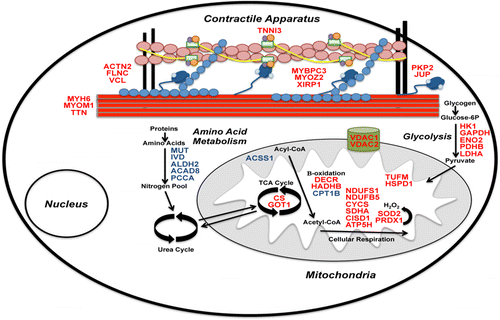A step toward understanding how hibernation protects hearts

Wintry weather means hats and scarves for some mammals, and hibernation for others. Hibernation dramatically lowers body temperatures, heart rates and oxygen consumption—things that would be fatal to other animals. A team reports in ACS' Journal of Proteome Research a study of the proteins and genes that allow squirrels' hearts to stay healthy during the winter. A better understanding of this phenomenon could help researchers develop better treatments for people with cardiac disease.
The thirteen-lined ground squirrel hibernates all winter, but it regularly wakens about once a week. Each time the squirrels go back into slumber, they lower their body temperatures to nearly zero degrees Celsius and reduce their oxygen usage to 2 percent of the aroused state. But they do not develop ischemia, ventricular fibrillation and other dangerous circulatory problems that would occur in most mammals, including humans. These cycles mean their body temperature and metabolism fluctuate substantially, putting their hearts through the wringer over and over. Studying the molecular mechanisms behind how hibernators avoid this physiological roller coaster could one day help researchers understand the biology behind human heart failure, stroke and obesity. So, how do the squirrels survive such extremes? To answer this question, Matthew Andrews and his colleagues at the University of Minnesota used advanced proteogenomic techniques.
The researchers monitored changes in the ground squirrels' protein expression during different stages of hibernation. They compared these results against the squirrel's recently sequenced genome using a data analysis platform the team developed, called Galaxy-P. This proteogenomic analysis found dozens of proteins and protein signaling pathways that are expressed differently during hibernation. For example, the PPAR signaling pathway was upregulated during hibernation and highlights some of the proteins required to maintain heart function during that process. The team notes that these insights may be translated into therapies to prevent and treat cardiovascular disease in humans in the future.
More information: Katie L. Vermillion et al. Characterizing Cardiac Molecular Mechanisms of Mammalian Hibernation via Quantitative Proteogenomics, Journal of Proteome Research (2015). DOI: 10.1021/acs.jproteome.5b00575
Abstract
This study uses advanced proteogenomic approaches in a nonmodel organism to elucidate cardioprotective mechanisms used during mammalian hibernation. Mammalian hibernation is characterized by drastic reductions in body temperature, heart rate, metabolism, and oxygen consumption. These changes pose significant challenges to the physiology of hibernators, especially for the heart, which maintains function throughout the extreme conditions, resembling ischemia and reperfusion. To identify novel cardioadaptive strategies, we merged large-scale RNA-seq data with large-scale iTRAQ-based proteomic data in heart tissue from 13-lined ground squirrels (Ictidomys tridecemlineatus) throughout the circannual cycle. Protein identification and data analysis were run through Galaxy-P, a new multiomic data analysis platform enabling effective integration of RNA-seq and MS/MS proteomic data. Galaxy-P uses flexible, modular workflows that combine customized sequence database searching and iTRAQ quantification to identify novel ground squirrel-specific protein sequences and provide insight into molecular mechanisms of hibernation. This study allowed for the quantification of 2007 identified cardiac proteins, including over 350 peptide sequences derived from previously uncharacterized protein products. Identification of these peptides allows for improved genomic annotation of this nonmodel organism, as well as identification of potential splice variants, mutations, and genome reorganizations that provides insights into novel cardioprotective mechanisms used during hibernation.
Journal information: Journal of Proteome Research
Provided by American Chemical Society





















